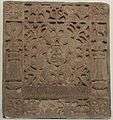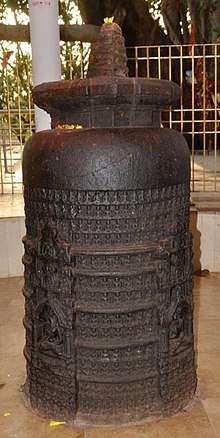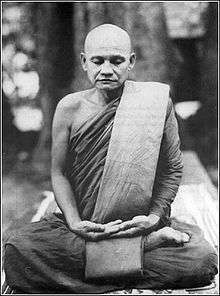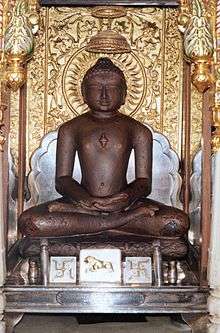Buddhism and Jainism
Buddhism and Jainism are two ancientIndian religions that developed in Magadha (Bihar) and continue to thrive in the modern age.This is a comparative study Mahavira and Gautama Buddha are generally accepted as contemporaries.[1][2] Jainism and Buddhism share many features, terminology and ethical principles, but emphasize them differently.[2] Both are śramaṇa ascetic traditions that believe it is possible to attain liberation from the cycle of rebirths and deaths (samsara) through spiritual and ethical disciplines.[3] They differ in some core doctrines such as those on asceticism, Middle Way versus Anekantavada, and self versus no-self (jiva, atta, anatta).[2][4]
| Part of a series on |
| Jainism |
|---|
 |
|
Jain prayers |
|
Ethics |
|
Major sects |
|
Texts |
|
Festivals
|
|
|
| Part of a series on |
| Buddhism |
|---|
 |
|
|
|
History
Jainism is an ancient religion and eternal with 24 Tirthankaras. Of the 24, the last two Mahavira – are generally accepted as historical persons, with the 23rd Tirthankara pre-dating the Buddha and the Mahavira by probably some 250 years.[5] Buddhists believe Gautama Buddha, the historical buddha, rediscovered the long forgotten dharma around the 5th century BCE, and began to teach it again. In Buddhism there were previous buddhas, too, 27 in total as described in the Buddhavamsa, the 14th book of the Khuddaka Nikāya.[6][7][8][9] Buddhists also believe that Gautama Buddha had many previous rebirths as described in the Jataka Tales.[10]
Buddhist scriptures record that during Prince Siddhartha's ascetic life (before attaining enlightenment) he undertook many fasts, penances and austerities, the descriptions of which are elsewhere found only in the Jain tradition. In the Majjhima Nikaya, the Buddha shares his experience:[11]
Thus far, Sāriputta, did I go in my penance? I went without clothes. I licked my food from my hands. I took no food that was brought or meant especially for me. I accepted no invitation to a meal.
The Jain text of Kalpasutra confirms Mahavira's asceticism, whose life is a source of guidance on many of the ascetic practices in Jainism.[12] Such asceticism has been a hallmark of mendicant life in Jainism.[13] The Buddha tried it, but abandoned what he called the "extreme ascetic methods", teaching the Middle Way instead.[14]

 Sahastrakoot (1008) Jinalaya, Bhadrakali in Itury
Sahastrakoot (1008) Jinalaya, Bhadrakali in Itury Multiple depictions of Buddha on a wall at Ajanta Caves
Multiple depictions of Buddha on a wall at Ajanta Caves
Jainism in Buddhist Texts
Pāli Canon
The Pāli Canon does not record that Mahavira and Gautama Buddha ever met, though instances of Mahavira's disciples questioning Gautama Buddha are to be found in various sutras. For instance, in the Majjhima Nikāya (MN 56), Upāli —one of Gautama Buddha's foremost disciples— is said to have been a disciple of the Mahavira who became a disciple of the Buddha after losing a debate with him.[15] The Buddhists have always maintained that by the time the Buddha and Mahavira were alive, Jainism was already an entrenched faith and culture in the region. According to the Pāli Canon, Gautama was aware of Mahavira's existence as well as the communities of Jain monastics
Buddhist texts refer to the Mahavira as Nigaṇṭha Jñātaputta.[16] Nigaṇṭha means "without knot, tie, or string" and Jñātaputta (son of Natas), referred to his clan of origin Jñāta or Naya (Prakrit).[17]
The five vows (non-violence, truth, non-attachment, non-thieving, celibacy/chastity) propounded by the 23rd Jain Tirthankara, Pārśva (877-777 BCE),[16] may have been the template for the Five Precepts of Buddhism. Additionally, the Buddhist Aṅguttaranikāya scripture quotes the independent philosopher Purana Kassapa, a sixth-century BCE founder of a now-extinct order, as listing the "Nirgranthas" as one of the six major classifications of humanity.
Buddhist writings reflect that Jains had followers by the time the Buddha lived. Suggesting close correlations between the teachings of the Jains and the Buddha, the Majjhima Nikaya relates dialogues between the Buddha and several members of the "Nirgrantha community".
Indian Buddhist tradition categorized all non-Buddhist schools of thought as pāsaṇḍa "heresy" (pasanda means to throw a noose or pasha—stemming from the doctrine that schools labelled as Pasanda foster views perceived as wrong because they are seen as having a tendency towards binding and ensnaring rather than freeing the mind). The difference between the schools of thought are outlined.
Divyavadana
The ancient text Divyavadana (Ashokavadana is one of its sections) mention that in one instance, a non-Buddhist in Pundravardhana drew a picture showing the Buddha bowing at the feet of Mahavira. On complaint from a Buddhist devotee, Ashoka, the Maurya Emperor, issued an order to arrest him, and subsequently, another order to kill all the Ājīvikas in Pundravardhana. Around 18,000 Ājīvikas were executed as a result of this order.[18] Sometime later, another ascetic in Pataliputra drew a similar picture. Ashoka burnt him and his entire family alive in their house.[19] He also announced an award of one dinara (silver coin) to anyone who brought him the head of a Jain. According to Ashokavadana, as a result of this order, his own brother, Vitashoka, was mistaken for a heretic and killed by a cowherd. Their ministers advised that "this is an example of the suffering that is being inflicted even on those who are free from desire" and that he "should guarantee the security of all beings". After this, Ashoka stopped giving orders for executions.[18]
According to K. T. S. Sarao and Benimadhab Barua, stories of persecutions of rival sects by Ashoka appear to be a clear fabrication arising out of sectarian propaganda.[19][20][21]
Buddhist Texts in Jain Libraries
According to Padmanabh Jaini, Vasudhara Dharani, a Buddhist work was among the Jainas of Gujarat in 1960s, and a manuscript was copied in 1638 CE.[22] The Dharani was recited by non-Jain Brahmin priests in private Jain homes.
Shared terminology
 Buddha with Mucalinda Naga, Sri Lanka
Buddha with Mucalinda Naga, Sri Lanka- Parshvanatha with Dharanendra
The shared terms include Sangha, Shramana (monk), Shravaka (Householder in Jainism, Buddha's disciple in Buddhism), Jina (Tirthankara in Jainism, Buddha in Buddhism), Chaitya, Stupa, Pudgala (Matter in Jainism, soul in Buddhism) etc. Early Jainism used stupas, although the practice mostly (but not completely) was abandoned later.[23]
Similarities
.jpg) Jain Stupa, Kankali Tila
Jain Stupa, Kankali Tila Buddhist stupa worship, Sanchi
Buddhist stupa worship, Sanchi Mahaveer - Nagamalai Puthukottai, Tamil Nadu, ardha-padmasana
Mahaveer - Nagamalai Puthukottai, Tamil Nadu, ardha-padmasana.jpg)
_(14181847087).jpg) Tirthankara Sravanabelgola, Kayotsarga sana
Tirthankara Sravanabelgola, Kayotsarga sana- Buddha - Kushan Period, standing
In Jainism, the way of liberation is the ford (tirtha), and Tirthankaras "those making the ford" (from samsara to moksha) are supreme teachers.[24] Same concept is found in Buddhism which says that through enlightenment (bodhi) an individual crosses the river of samsara and attain liberation. Both religions deny the existence of a creator god.[25] Buddhism and Jainism evince a shared belief in the existence of geographical regions beyond the parameters of Bharatavarsha, access to which could not be gained by ordinary human beings.[26]
Karakandu, a Pratyekabuddha in both Jainism and Buddhism, is a rare personality that is shared between Jainism and Buddhism.[27] The Jain text Isibhasiyam mentions Vajjiyaputra, Mahakashyap and Sariputra among the rishis.[28]
The Jain community (or Jain sangha) consists of monastics, munis (male ascetics) and aryikas (female ascetics) and householders, śhrāvaks (laymen) and śrāvakīs (laywomen). Buddhism has a similar organization: the community consists of renunciate bhikkhus and bhikkhunis and male and female laypersons, or śrāvakas and śrāvikas, who take limited vows.
Jain and Buddhist iconography can be similar. In north India, the sitting Jain and Buddhist images are in padmasana, whereas in South India both Jain and Buddhist images are in ardha-padmasana (also termed virasana in Sri Lanka). However the Jina images are always samadhi mudra, where as the Buddha images can also be in bhumi-sparsha, dharam-chakra-pravartana and other mudras. The standing Jain images are always in khadgasana or kayotsarga asana.
Differences
 Theravada Buddhist monk, Thailand
Theravada Buddhist monk, Thailand Digambara Jain monk, India
Digambara Jain monk, India
Jainism has developed and refined the non-violence ('Ahimsa) doctrine to an extraordinary degree where it is an integral part of the Jain culture.[29][30] Jain vegetarianism, for example, is driven by the principle of not harming any animals and both lay and mendicants are predominantly vegetarian.[31] In Buddhism, Mahayana monks in China, Japan (see Shojin-ryori), Korea and Vietnam are vegetarian; however, vegetarianism is not required for lay Buddhists. In Theravada monastic tradition, a monk should eat whatever is placed in his bowl when receiving food.
Although both Buddhists and Jain had orders of nuns, Buddhist Pali texts record the Buddha saying that a woman has the ability to obtain nirvana in the dharma and Vinaya. According to Digambara Jains, women are capable of spiritual progress but must be reborn as a man in order to attain final spiritual liberation. The religious texts of the Śvētāmbaras mention that liberation is attainable by both men and women.[32]
Jains believe in the existence of an eternal Jiva (soul),[33] whereas Buddhism denies the concept of self (jiva) or soul (atman), proposing the concept of no-self (anatta) instead.[34][35]
The Anekantavada doctrine is another key difference between Jainism and Buddhism. The Buddha taught the Middle Way, rejecting extremes of the answer "it is" or "it is not" to metaphysical questions. The Mahavira, in contrast, accepted both "it is" and "it is not", with "perhaps" qualification and with reconciliation.[36]
Jainism discourages monks and nuns from staying in a single place for a long time, with the exception of 4 months in the rainy season (chaturmas). Thus most of the time the Jain monks and nuns keep wandering, staying in a place for just a few days. Some Theravada Buddhist monks also observe vassa rules, but often they stay in one monastery.[2]
References
Citations
- Dundas, Paul (2003). Jainism and Buddhism, in Buswell, Robert E. ed. Encyclopedia of Buddhism, New York: Macmillan Reference Lib. ISBN 0028657187; p. 383
- Damien Keown; Charles S. Prebish (2013). Encyclopedia of Buddhism. Routledge. pp. 127–130. ISBN 978-1-136-98588-1.
- Zimmer 1953, p. 266.
- [a] Christmas Humphreys (2012). Exploring Buddhism. Routledge. pp. 42–43. ISBN 978-1-136-22877-3.
[b] Brian Morris (2006). Religion and Anthropology: A Critical Introduction. Cambridge University Press. pp. 47, 51. ISBN 978-0-521-85241-8., Quote: "...anatta is the doctrine of non-self, and is an extreme empiricist doctrine that holds that the notion of an unchanging permanent self is a fiction and has no reality. According to Buddhist doctrine, the individual person consists of five skandhas or heaps—the body, feelings, perceptions, impulses and consciousness. The belief in a self or soul, over these five skandhas, is illusory and the cause of suffering."
[c] Richard Gombrich (2006). Theravada Buddhism. Routledge. p. 47. ISBN 978-1-134-90352-8., Quote: "...Buddha's teaching that beings have no soul, no abiding essence. This 'no-soul doctrine' (anatta-vada) he expounded in his second sermon." - Dundas 2002, pp. 30-33.
- Horner, IB, ed. (1975). The minor anthologies of the Pali canon. Volume III: Buddhavaṁsa (Chronicle of Buddhas) and Cariyāpiṭaka (Basket of Conduct). London: Pali Text Society. ISBN 0-86013-072-X.
- Vicittasarabivamsa, U (1992). "Chapter IX: The chronicle of twenty-four Buddhas". In Ko Lay, U; Tin Lwin, U (eds.). The great chronicle of Buddhas, Volume One, Part Two (PDF) (1st ed.). Yangon, Myanmar: Ti=Ni Publishing Center. pp. 130–321.
- Law, Bimala Churn, ed. (1938). "The lineage of the Buddhas". The Minor Anthologies of the Pali Canon: Buddhavaṃsa, the lineage of the Buddhas, and Cariyā-Piṭaka or the collection of ways of conduct (1st ed.). London: Milford.
- Takin, MV, ed. (1969). "The lineage of the Buddhas". The Genealogy of the Buddhas (1st ed.). Bombay: Bombay University Publications.
- Jataka, Encyclopœdia Britannica.
- Pruthi, R.K. (2004). Buddhism and Indian Civilization. Discovery Publishing House. p. 197. ISBN 978-81-71418664. Retrieved 1 April 2015.
- Jacobi, Hermann (1884). F. Max Müller (ed.). The Kalpa Sūtra (Translated from Prakrit). Sacred Books of the East vol.22, Part 1. Oxford: The Clarendon Press. ISBN 0-7007-1538-X. Note: ISBN refers to the UK:Routledge (2001) reprint of original text published in 1884
- Jain & Upadhye 2000, p. 58.
- Collins 2000, p. 204.
- "Majjhimanikāya - Upāli Sutta" (MN 56)
- Sangave 2001, p. 21.
- Zimmer 1953, p. 223.
- John S. Strong (1989). The Legend of King Aśoka: A Study and Translation of the Aśokāvadāna. Motilal Banarsidass Publ. pp. 232–233. ISBN 978-81-208-0616-0. Retrieved 30 October 2012.
- Benimadhab Barua (5 May 2010). The Ajivikas. General Books. pp. 68–69. ISBN 978-1-152-74433-2. Retrieved 30 October 2012.
- Steven L. Danver, ed. (22 December 2010). Popular Controversies in World History: Investigating History's Intriguing Questions: Investigating History's Intriguing Questions. ABC-CLIO. p. 99. ISBN 978-1-59884-078-0. Retrieved 23 May 2013.
- Le Phuoc (March 2010). Buddhist Architecture. Grafikol. p. 32. ISBN 978-0-9844043-0-8. Retrieved 23 May 2013.
- Vasudhara dharani A Buddhist work in use among the Jainas of Gujarat, Padmanabh S Jaini, Mahavir Jain_Vidyalay Suvarna_Mahotsav Granth Part 1, 2002, p. 30-45.
- Buddhism in the Shadow of Brahmanism, Johannes Bronkhorst, Brill, 2011, p. 132
- Zimmer 1953, p. 474.
- Sangave 2001, p. 139.
- Patrick Olivelle 2006, p. 396.
- [Ascetic Figures Before and in Early Buddhism: The Emergence of Gautama as the Buddha, Issue 30 of Religion and reason, ISSN 0080-0848, Martin G. Wiltshire, Walter de Gruyter, 1990p. 112]
- "RISHI BHASHIT AND PRINCIPLES OF JAINISM By Dr. Sagar Mal Jain". Archived from the original on 8 November 2016. Retrieved 8 November 2016.
- Dundas 2002, pp. 176–177.
- Winternitz 1993, pp. 408–409.
- Sangave 1980, p. 260.
- Jaini, Padmanabh S. (1991). Gender and salvation : Jaina debates on the spiritual liberation of women. Berkeley: University of California Press. ISBN 9780520068209.
- Sangave 2001, p. 140.
- John C. Plott et al (2000), Global History of Philosophy: The Axial Age, Volume 1, Motilal Banarsidass, ISBN 978-8120801585, page 63, Quote: "The Buddhist schools reject any Ātman concept. As we have already observed, this is the basic and ineradicable distinction between Hinduism and Buddhism".
- [a] Anatta, Encyclopædia Britannica (2013), Quote: "Anatta in Buddhism, the doctrine that there is in humans no permanent, underlying soul. The concept of anatta, or anatman, is a departure from the Hindu belief in atman (“the self”).";
[b] Steven Collins (1994), Religion and Practical Reason (Editors: Frank Reynolds, David Tracy), State Univ of New York Press, ISBN 978-0-7914-2217-5, page 64; Quote: "Central to Buddhist soteriology is the doctrine of not-self (Pali: anattā, Sanskrit: anātman, the opposed doctrine of ātman is central to Brahmanical thought). Put very briefly, this is the [Buddhist] doctrine that human beings have no soul, no self, no unchanging essence.";
[c] Katie Javanaud (2013), Is The Buddhist ‘No-Self’ Doctrine Compatible With Pursuing Nirvana?, Philosophy Now;
[d] David Loy (1982), Enlightenment in Buddhism and Advaita Vedanta: Are Nirvana and Moksha the Same?, International Philosophical Quarterly, Volume 23, Issue 1, pages 65-74;
[e] KN Jayatilleke (2010), Early Buddhist Theory of Knowledge, ISBN 978-8120806191, pages 246-249, from note 385 onwards;
[f] Bruno Nagel (2000), Roy Perrett (editor), Philosophy of Religion: Indian Philosophy, Routledge, ISBN 978-0815336112, page 33 - Matilal 1998, pp. 128–135.
Sources
- Collins, Randall (2000), The sociology of philosophies: a global theory of intellectual change, Harvard University Press, ISBN 978-0674001879
- Dundas, Paul (2002) [1992], The Jains (Second ed.), Routledge, ISBN 0-415-26605-X
- Matilal, Bimal Krishna (1990), Logic, Language and Reality: Indian Philosophy and Contemporary Issues, Motilal Banarsidass, ISBN 978-81-208-0717-4
- Matilal, Bimal Krishna (1998), Ganeri, Jonardon; Tiwari, Heeraman (eds.), The Character of Logic in India, State University of New York Press, ISBN 978-0-7914-3739-1
- Patrick Olivelle, ed. (2006), Between the Empires : Society in India 300 BCE to 400 CE, Oxford University Press, ISBN 978-0-19-530532-6
- Sangave, Vilas Adinath (2001a), Facets of Jainology: Selected Research Papers on Jain Society, Religion, and Culture, Popular Prakashan, ISBN 978-81-7154-839-2
- Sangave, Vilas Adinath (2001), Aspects of Jaina Religion, Bharatiya Jnanpith, ISBN 978-81-263-0720-3
- Sangave, Vilas Adinath (1980), Jaina Community: A Social Survey (2nd ed.), Bombay: Popular Prakashan, ISBN 978-0-317-12346-3
- Jain, Hiralal; Upadhye, Dr. Adinath Neminath (2000), Mahavira his Times and his Philosophy of Life, Bharatiya Jnanpith
- Zimmer, Heinrich (1953). Joseph Campbell (ed.). Philosophies of India. London, E.C. 4: Routledge & Kegan Paul Ltd. ISBN 978-81-208-0739-6.CS1 maint: location (link) CS1 maint: ref=harv (link)
- Winternitz, Moriz (1993), History of Indian Literature: Buddhist & Jain Literature, Motilal Banarsidass, ISBN 978-81-208-0265-0

